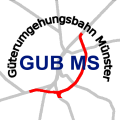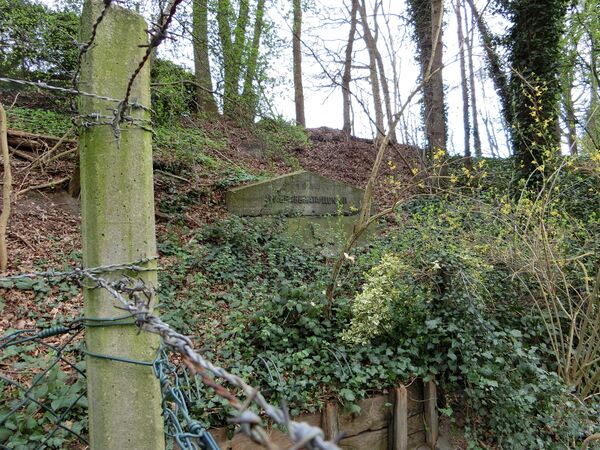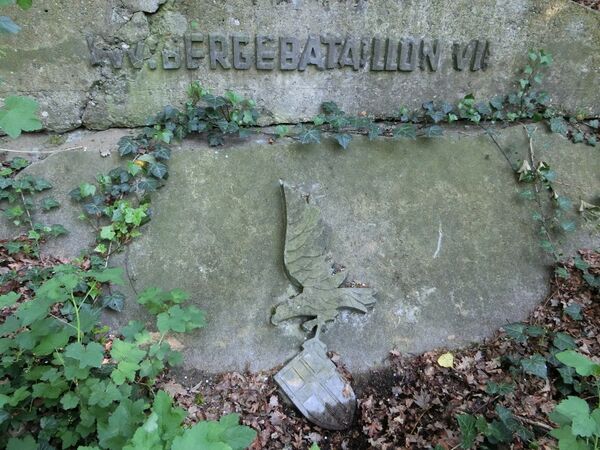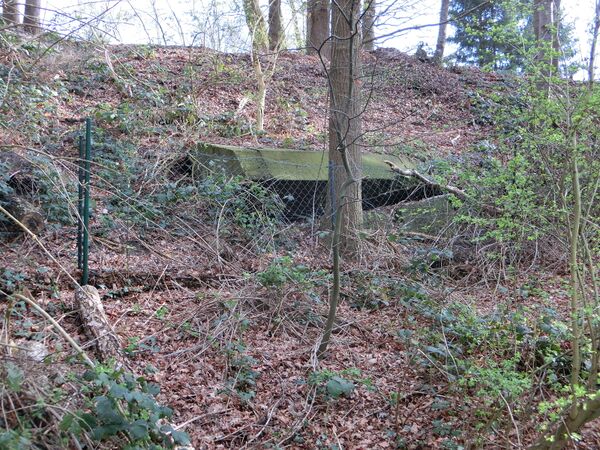Historie: Der Bunker des Luftwaffenbergebataillon VII
Zurück zu Historie: Die Anschlussstelle Bahndepot / Hoch zur Beschreibung / Weiter zu Historie: Der geplante Ortsgüterbahnhof in der Loddenheide
Fundsachen
Südwestlich vom Albersloher Weg gibt es eine breite Aufschüttung, auf der sich heute die Kleingartenanlage "Birkenhöhe" befindet (ohne Punkte auf dem "ö"). Auf der Nordseite sind einige Überreste aus Beton zu sehen, deren Herkunft ich nachgegangen bin.
Im Stadtarchiv Münster und im Internet habe ich zu den Überresten nichts gefunden. Den einzigen Hinweis habe ich von der Inschrift über dem mutmaßlichen Eingang. Diese nennt eine Einheit der Wehrmacht (genauer: der Luftwaffe), nämlich das "Luftwaffenbergebataillon VII". Dazu gibt es ein paar Informationen (s. unten). Wenn Sie etwas wissen - bitte nehmen Sie Kontakt auf!
Linker oder zentraler Eingang (?), aus der Ferne
Linker oder zentraler Eingang (?) mit Inschrift "LW. BERGEBATAILLON VII", aus der Nähe
Rechter Eingang (?), aus der Ferne
Die Geschichte des Luftwaffenbergebataillons
- 1940 Luftzeugstab 6 gegründet
- 1942 Übergang in Luftzeugstab 107
- Winter 1943/44 umbenannt in Luftwaffen-Berge-Bataillon 7
Aus www.forums.luftwaffedata.co.uk, gepostet von Andy Mitchell (LuftwaffeData Forum Site Admin), der die Info von Larry deZeng hat:
"Here is what I have on Lw.-Berge-Btl. VII. I do not know what the bunker is for, but my guess would be that it was just an air raid bunker reserved for the use of the battalion staff. It had no function other that to investigate, secure and salvage crashed aircraft, both German and enemy, this being done over a very large area. The salvaged metal was sent directly to a smelting facility and not to Loddenheide."
Lw.-Berge-Bataillon VII
Formed 1 September 1943 in Germany by renaming Luftzeugstab 107. Under Luftwaffen-Befehlshaber Mitte (later re-designated Luftflotte Reich), it consisted of a Stab only that controlled the following independent units:
- Landesschützen-Kp. 3/XVII,
- Landesschützen-Züge 40/IV, 66/VI, 336/VI, 339/VI and 458/VI,
- Flugzeugbergungstrupps 15/III, 16/III, 17/III, 18/III, 19/III and 20/III.[1]
The mission of the Bataillon was to guard the sites of crashed aircraft and salvage the remnants.
Service History
- 18 Oct 43: a Saimann 202 Italian-built liaison, training and general purpose single-engine aircraft belonging to the Bataillon crashed near Rome-Ciampino airfield after being shot up by enemy planes.[2] Note: all of these Berge-Bataillonen had one or more light aircraft used to search for crashed planes. This one was being picked up in Italy at this time.
- 4 May 44: Bataillon at Münster-Loddenheide.[3]
- Jan 45: Münster-Loddenheide. Bataillon responsible for the entire West area from the Dutch coast to the Saar, including the Ruhr area.[4]
- Mar 45: Münster-Loddenheide.[5]
FpN: L 10271.
Commander
Maj. Viktor Schobinger (13 Sep 1943 - ? CT: 24 May 1989)
Sources
[1] Org.Abt./Genst.d.Lw. 12781/43.
[2] BA-MA Freiburg: Loss Reports for the school units.
[3] Jet & Prop Magazin, Heft 6/96, Seite (page) 19.
[4] P/W interrogation ADI(K) 243/45.
[5] British Air Ministry air intelligence report."
Links
Tipp: "Luftwaffen-Berge-Bataillon 7" ist ein guter Suchbegriff.
- [1] Liste der Luftwaffen-Berge-Bataillone
- [2] Liste der Luftzeugstäbe
- [3] Thread auf "12 O'Clock High!" zum Luftwaffen-Berge-Bataillon 7
- [4] Lexikon der Wehrmacht
- [5] Wikipedia zu Kommandeur Viktor Schobinger
- [6] Meine Recherche zum Bunker auf "www.forums.luftwaffedata.co.uk"
Zurück zu Historie: Die Anschlussstelle Bahndepot / Hoch zur Beschreibung / Weiter zu Historie: Der geplante Ortsgüterbahnhof in der Loddenheide



